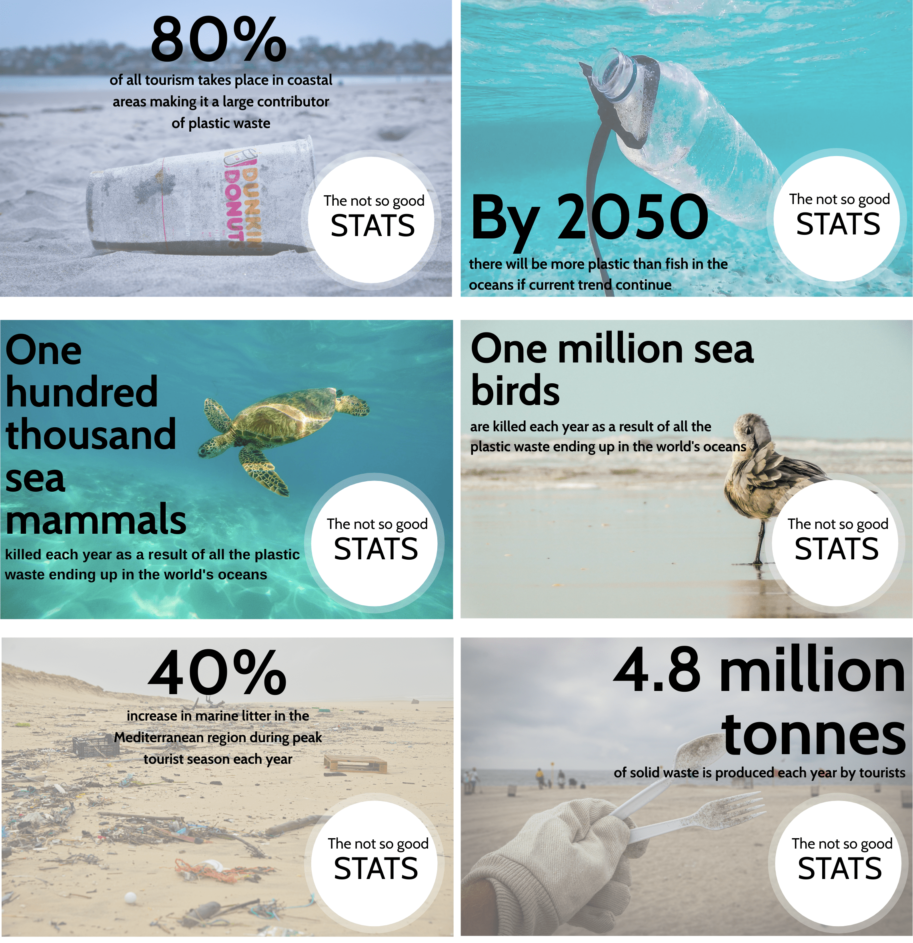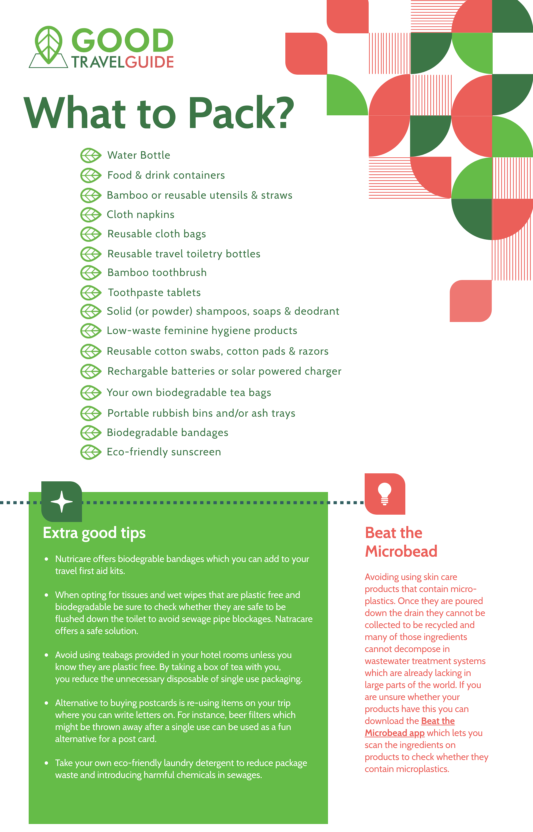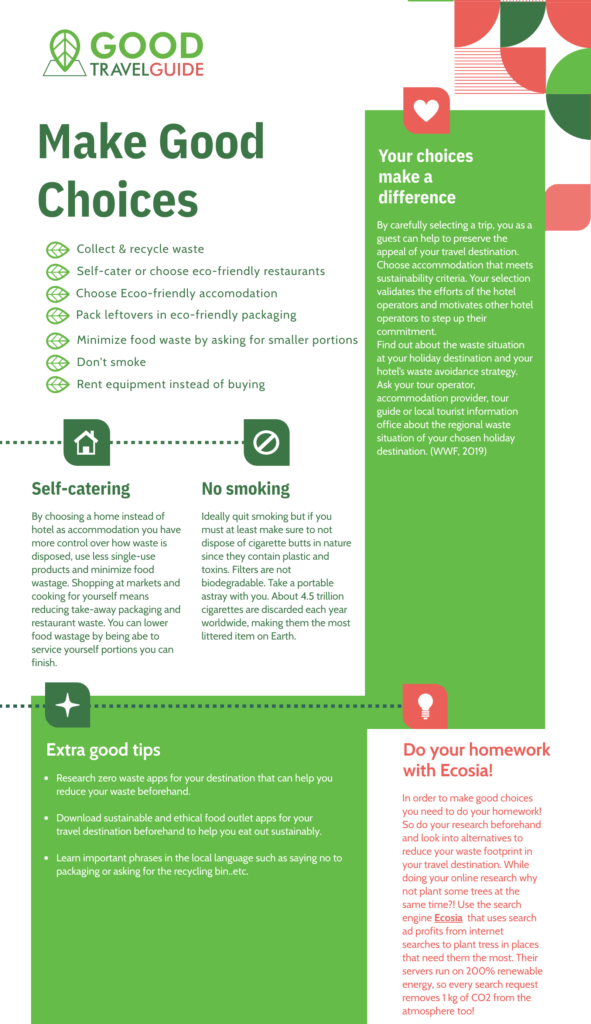© Good Travel Guide, January 2021
Co-authors: Paula Radman & Ramona Mendis, Editors: Jaspal Channa & Daniela van Elburg
Prior to the COVID-19 Pandemic, 2019 saw a record total of 671 million international tourists arrivals in the first half of the year. This was 30 million more than in the first half of 2018. If the COVID-19 pandemic had not hit, these numbers were expected to continue rising in 2020.
[efn_note]UNWTO. “INTERNATIONAL TOURISM UP 4% IN FIRST HALF OF 2019, WORLD TOURISM ORGANIZATION REPORTS.” World Tourism Organization A United Nations Specialized Agency, UNWTO Communications Department, 09 September 2019. Accessed 06 January 2021.[/efn_note]
The problem with these rising numbers is that tourists were found to generate up to twice the amount of solid waste per capita of local residents, with a particular increase in plastic and single-use items.
[efn_note]Styles, D., Schönberger, H., & Galvez Martos, J. L. (2013). JRC Scientific and Policy Report on Best Environmental Management Practice in the Tourism Sector. European Commission.[/efn_note]
[efn_note]Bauske, B., von Münchhausen, M., Plitharas, A., & Tsoukalas, K. (2019). Stop the flood of plastic: Effective measures to avoid single-use plastics and packaging in hotels. WWF Germany[/efn_note]
The additional waste produced by tourists puts increased pressure on local waste management infrastructures. In addition, litter also reduces the aesthetic value of destinations making them less attractive to visitors. Marine litter is a particularly important issue in coastal destinations, as it was found to increase by up to 30% during peak tourist season.
[efn_note]Dalberg Advisors. (2019). Stop the Flood of Plastic: How Mediterranean countries can save their sea. WWF Mediterranean Marine Initiative.[/efn_note]
When local infrastructures cannot handle or have improper management of waste, this can result in serious harm to both the environment and public health. Impacts to the environment can include air and water pollution, resource depletion, soil degradation, loss of biodiversity and aesthetic value. Furthermore, the waste sector alone produces around 3% of global greenhouse gas (GHG) emissions.
[efn_note]IPCC. (2014). Climate Change 2014: Mitigation of Climate Change. Contribution of Working Group III to the Fifth Assessment Report of the Intergovernmental Panel on Climate Change. Cambridge University Press.[/efn_note]
The invisible threat
Most people associate waste with single use and/or plastic items which are visible but there is another type of invisible waste that poses a huge threat: microplastics and microbeads. These are found in many skin care products and once they are poured down the drain they cannot be collected to be recycled.

Many of the plastic ingredients cannot decompose in wastewater treatment systems, which are also lacking in many parts of the world. This usually means they end up in rivers and then ultimately in the sea and are eaten by fish, amphibians, insects, larvae, and marine animals as well as seabirds and other marine life, blocking digestive tracts and causing physical problems. Reducing your micro-plastic waste is not only essential when staying at home but also when travelling to prevent detrimental impact to local environments.
[efn_note]United Nations. “Microplastics, microbeads and single-use plastics poisoning sea life and affecting humans.” UN News, 04 November 2019. Accessed 06 January 2021.[/efn_note]
The not so good stats
At the Good Travel Guide we aim to provide you with advice on being a good tourist and looking after your surroundings when travelling. However, in order for you to understand the issues we first need to introduce to you to some of the not so good facts and statistics on the realities of (plastic) waste and the impact it has on travel and tourism.

Pictures 1 to 5
[efn_note]One Planet Network. “Tourism’s Plastic Pollution Problem.” One Planet Network. Accessed 21 January 2021.[/efn_note]
. Picture 6
[efn_note]McDowall, Jennifer. “MANAGING WASTE IN TOURIST CITIES.” Resource: Sharing knowledge to promote waste as a resource, 22 August 2016. Accessed 21 January 2021.[/efn_note]
Be part of the solution!
So how do you reduce your waste footprint, when travelling and in your day to day consumption? The first most effective and cost-efficient way is reducing the amount of plastic you consume, followed by reusing and recycling.
In fact, by following these practices it is estimated that 15-20% of global GHG emissions could be reduced.
[efn_note]UNEP & ISWA. (2015). Global Waste Management Outlook (GWMO). United Nations Environment Programme.[/efn_note]
Because clean-up and recycling of litter is an expensive process, avoiding and reducing your litter is a much more cost-effective and favourable alternative.
[efn_note]Hu, H., Zhang, J., Chu, G., Yang, J., & Yu, P. (2018). Factors influencing tourists’ litter management behavior in mountainous tourism areas in China. Waste Management, 79(1), 273-286. ScienceDirect.[/efn_note]
By reducing your (plastic) waste when travelling you help alleviate any additional impact on local infrastructure and the environment.
How to travel plastic free?
Your zero or reduction in waste starts before you even leave. When packing your case make sure you pack reusable alternatives for all the single-use items you would otherwise have bought for or picked up throughout your trip.

If you don’t own any of these sustainable products, investing in them will save you both money and time in the long term, as you will be able to take them along with you on all future travels.
The Good Travel Guide has created a downloadable guide with advice on how to reduce your (plastic) waste footprint and to ensure that when you travel you create little or no waste along the way.


Throughout our travels we are constantly being offered single-use or disposable items that we pick up or use without thinking twice, and these can very quickly end up in the bin and in a landfill.
An important way of reducing our waste production is therefore to develop the habit of politely rejecting and saying “no!” to these items or services if they are simply not necessary. They are usually provided to guests or customers out of convenience, but you can almost always find a sustainable alternative, especially if you are already prepared.
The below infographic gives you some guidelines about when to say “no!” and how your voice can provide a positive impact on the (plastic) waste problem when travelling!





